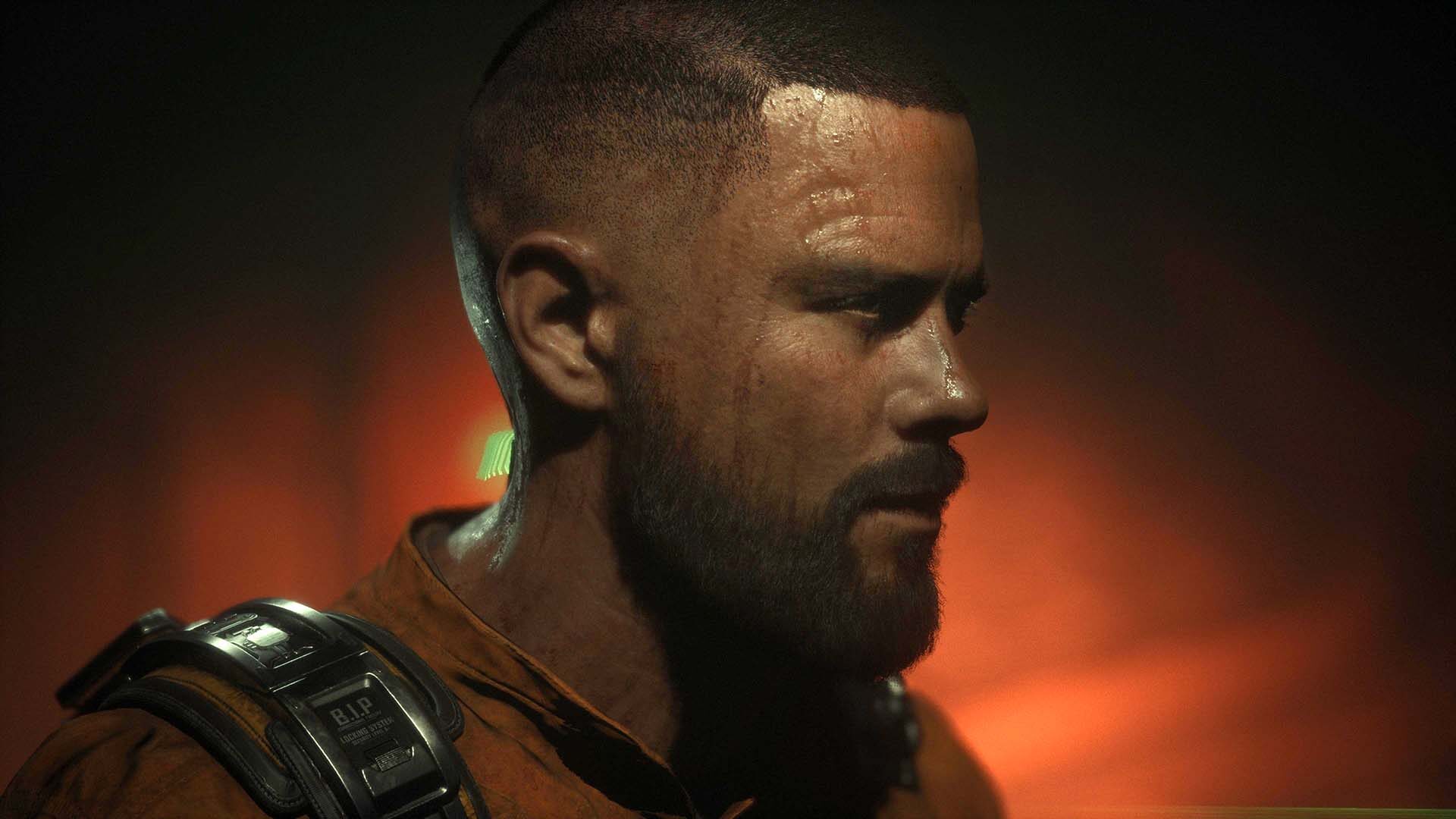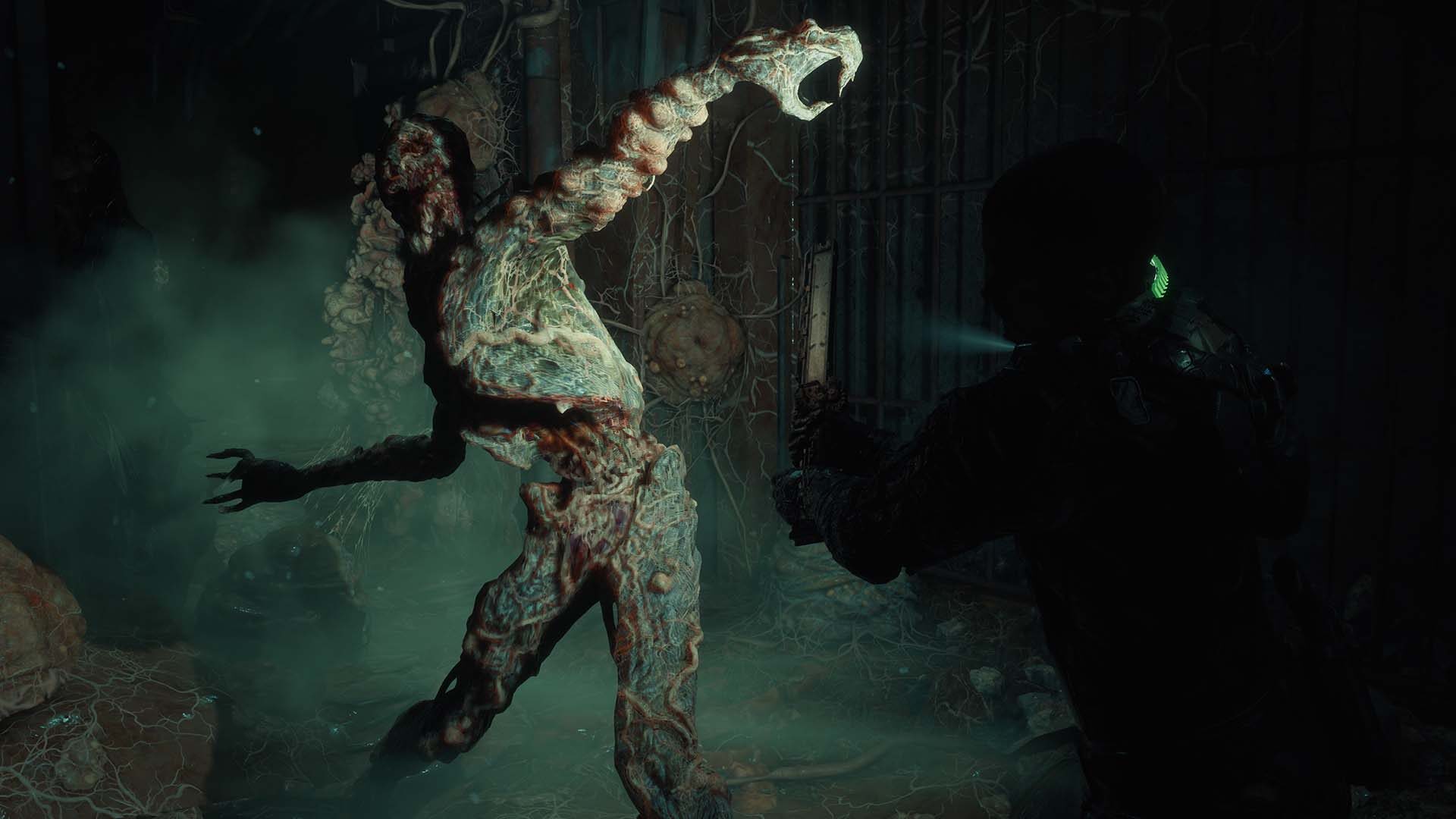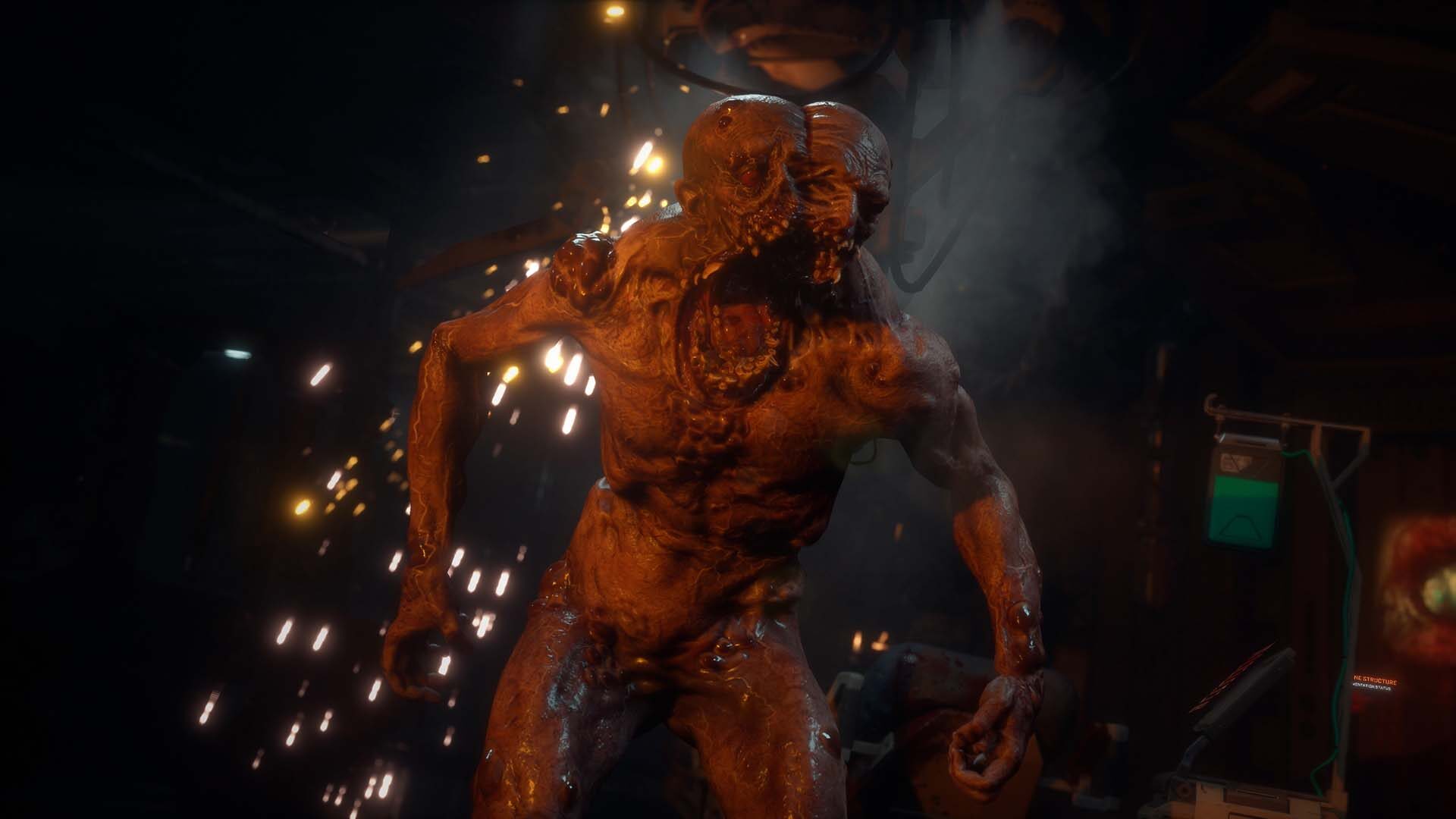Despite being set 300 years in the future, The Callisto Protocol seems firmly rooted in the past—specifically that of Striking Distance Studios founder Glen Schofield. To say that this game outwardly resembles another space-themed horror-action release that Schofield co-created for Electronic Arts would be a massive understatement. From the form-fitting futuristic armor, to the health bar on the back of the main character’s neck, to the hunched way that your character skulks the halls, Callisto Protocol’s aesthetics seem to crib a lot from Dead Space. And that’s not to mention the most obvious parallel, which is the fact that you’re killing mutated humanoid zombies somewhere in space.
Beyond the obvious Dead Space comparisons, though, there’s something else about Callisto Protocol that feels maybe not archaic, but certainly vintage. It’s a focused, narrative-driven, mostly linear adventure with a B-movie plot, uneven pacing, an almost parodic amount of jump scares, and a handful of on-rails action sequences. Even its biggest talking point—the gross-out gore system where the enemies and the main character alike can explode into splash-zone-worthy amounts of blood—feels reminiscent of the ways publishers would try to market their games two decades ago. It’s bloody, it’s violent, it’s extreme!
The one place where Callisto Protocol truly feels modern is in its perfectly replicated celebrity faces, this time featuring those of Josh “He’s Not Timothy Olyphant” Duhamel and The Boys’ Karen Fukuhara. Duhamel and Fukuhara star as Jacob and Dani (close enough to “Sam”), who are both inmates of Black Iron Prison, a subsidiary of the United Jupiter Company, located on the moon Callisto—Dani because she just attacked Jacob’s UJC-owned cargo ship, and Jacob because, well, it’s a mystery!

The story is about as predictable as it gets—I don’t think it’s a spoiler to say that a spacefaring corporate conglomerate with its fingers in the private prison pie are into some shady dealings—but at least it’s competently presented. The presence of stars like Duhamel and Fukuhara, as well as Sam Witwer as scenery-chewing prison captain, lends a real Hollywood flavor to the plot’s obsession with having Jacob fumble across collapsing walkways, get separated from his allies, and fight his way through dark hallways covered in monster goop. Really, Callisto Protocol feels less like a survival-horror story and more like a big-budget disaster flick, with Jacob constantly getting stuffed into vents and having to perform maintenance on seemingly every generator in Black Iron. It could also have something to do with the very limited number of genuine scares the story produces that “horror” isn’t the first genre that comes to mind, but that doesn’t make it any less fun. You just might have to reconfigure your expectations for a different genre.
Callisto Protocol’s monsters are a big reason why the game doesn’t feel scary. While Dead Space’s necromorphs used the concept of mutated, reanimated corpses to instill a sense of uncanny terror around every corner, Callisto Protocol’s much-less-cooler-sounding biophages just don’t have the goods. Sure, they’re gross, but after a while you don’t even notice that. Mostly, the scariest thing about encountering a biophage is that it means you will have to engage with the game’s clunky combat system.
There are really three aspects to Callisto Protocol’s combat: its melee system, its ranged weapon attacks, and throwing enemies into hazards with a gravity glove. The only option the game gives you at the beginning is to engage with its bizarrely simple and frustratingly clunky melee combat system. When an enemy swings at you, holding your left stick to the right or left will dodge their attack. It doesn’t matter which direction you’re holding or which direction the attack is coming from, you just need to be moving to the side. However, if the enemy swings at you multiple times in a combo, you can’t repeat the same dodge direction twice in a row, as doing so will get you smacked in the face. In other words, if you dodge the first attack to the left, then you need to dodge the next one to the right. It’s really that simple. You can also hold back to block, but you will take a tiny bit of damage. Still, I guess you don’t have to worry about remembering which one of the two directions you just dodged in. After you finish dodging, you can then attack with your melee weapon, but if you attack during an enemy’s combo, they will still hit you. It’s all about having patience and timing your swings correctly.
In theory, the melee combat is an interesting one for a supposedly survival-horror game. When facing down multiple biophages, timing your dodges and your attacks correctly can get pretty hectic without stripping away all of your power or agency as other games in the genre might. But it’s also really boring and gets old fast. I often found myself getting hit even though I knew I was holding the stick in the correct direction, possibly because I wasn’t totally facing the enemy that was attacking me. Whatever the cause, because the melee system is so simple, I felt myself getting frustrated, rightly or not, about taking damage. Even more frustrating was knowing that I was holding the stick to dodge and getting killed in one shot by a boss a couple dozen times. Honestly, about three-quarters of the way through the game, after having to fight the same miniboss several times in a row, I just turned on the accessibility option that auto-dodges in the correct direction, that’s how sick of it I was. Maybe if the game had introduced more contextual detail to the animations, like dodging into a wall or falling to the ground in wetter, goopier areas, the simplicity of the combat would be more forgivable, but it just feels mindless and spotty.

The melee combat is only part of Callisto Protocol’s gameplay, though dodging remains critical throughout the game. You also have guns and a gravity glove, called the GRD, at your disposal. While the guns are basically your generic pistol, shotgun, assault rifle, and revolver (albeit 3D printed), the GRD is where you can find the real fun in Callisto Protocol, and where its overly hyped gore effects get their time in the spotlight. The GRD lets you pick up enemies or objects in the environment and send them flying into walls and over ledges. You can pick up conveniently placed explosive canisters or random rusty saw blades to chuck at incoming biophages, but you can also just pick up the biophages themselves and throw them into giant fans or spikes on the wall. Why there are spikes on the walls I have no idea, but at least they’re good for dismembering enemies.
The GRD is by and far the best weapon in the game, so for the sake of gameplay balance, it comes with an energy meter that takes a while to recharge if you don’t have any batteries for it on hand. That means that you’ll mostly be engaging with the less fun aspects of Callisto Protocol’s combat while waiting to use your gravity glove again, like having to eat your broccoli before getting to have your ice cream. Though I understand the design philosophy around not letting players just GRD their way through the game, the main issue I have is that it’s the only part of the game that’s genuinely fun. (Well, that and stomping every enemy you kill so that loot like health pickups, ammo, and credits will fly out of them like candy in a piñata. I could do that all day. In fact, every game should have a dedicated stomp button from here on out.)
Pacing is another issue that The Callisto Protocol faces, and that can’t be saved by a super-fun gravity glove. The game is mostly linear, but you’ll be spending a lot of time walking down hallways, shimmying through tight spaces, or crawling through vents, and not even for the sake of exploration. A couple of random enemies appear to keep you on your toes during these long walking segments, but there’s really a lot of time you’ll spend in the game doing absolutely nothing without feeling any sort of tension that I think the developer intended to create. In Dead Space, these quiet moments led you to reflect on the game’s intriguing setting and story while building tension about what you would find next. Because every narrative beat is so obvious in The Callisto Protocol, these moments don’t instill that same sense of wonder and end up feeling more like wasted time. There will be some side paths to go down where, at the end, you can find some kind of reward like Black Iron credits to buy upgrades to your weapons, but these feel more like attempts at extending the playtime than trying to give players genuine payoff for their curiosity and patience.
The weapon upgrade system also seems a bit off in its execution. The guns apparently get stronger, but they don’t really feel all that different, other than having to reload less often with a larger magazine. Upgrading your melee weapon gets you a few more combat moves, but you really don’t need them against most enemies. On the other hand, when fully upgraded, the GRD can basically explode enemies against any walls, not just spiked ones. It feels like a genuine improvement, making the decision of where to spend your money a relatively arbitrary one. A much better system would have been to simply make upgrades rewards for exploration and hide them throughout the map. Instead, you just end up stomping dead bodies, hoping some cash will pop out.
From a technical standpoint, Callisto Protocol looks great. On Xbox Series X, its environments are richly detailed and its facial animations are creepily realistic. That being said, its frame rate at times felt particularly sluggish, and its lighting left a lot to be desired. In fact, I had to turn on the high contrast accessibility option and bump up the brightness to max during a particularly intense combat situation just so I could see where enemies were coming from. But, on the whole, Callisto Protocol’s presentation is probably its strongest suit. Watching Josh Duhamel getting his face caved in in beautifully crisp 4K, I had to ask myself if his agents really knew what he was getting himself into when he signed up for this project.
Despite its issues (or maybe because of them), I found The Callisto Protocol oddly comforting—it does feel like a throwback to a simpler time, complete with a sluggish frame rate on Xbox Series X and unnecessarily long death animations for Jacob. Even the checkpoints are poorly spaced out. Ah, just like the good old days! In all seriousness, the game can be fun in a cheesy, campy, mindless sort of way, but it can also be incredibly frustrating and unrewarding. It’s got some good ideas, but it never fully develops them, and often feels like Striking Distance taking a bunch of concepts that never got put into Dead Space and throwing them at the wall. Just like doing so to the biophages, it resulted in a glorious mess, but a mess nonetheless.

Images: Krafton
|
★★★☆☆
The Callisto Protocol feels like a throwback title, for better and worse. While the Dead Space comparisons are unavoidable, director Glen Schofield’s return to survival horror does bring with it several new concepts, but many, like the melee combat system, suffer from poor execution. Still, if you’re looking for a fun, B-movie disaster story with some famous Hollywood faces and a more straightforward, linear single-player experience, you could do worse—at least until the Dead Space remake launches next year. |
Developer Striking Distance Studios Publisher Krafton ESRB M - Mature Release Date 12.02.2022 |
| The Callisto Protocol is available on Xbox Series X/S, PlayStation 5, Xbox One, PlayStation 4, and PC. Primary version played was for Xbox Series X. Product was provided by Krafton for the benefit of this coverage. EGM reviews on a scale of one to five stars. | |

Michael Goroff has written and edited for EGM since 2017. You can follow him on Twitter @gogogoroff.